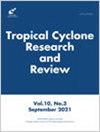在大型河流系统中,作为生态生物指标的水生生物对气旋干预的响应——以印度恒河为例
IF 4.1
4区 地球科学
Q3 METEOROLOGY & ATMOSPHERIC SCIENCES
引用次数: 0
摘要
气旋干扰会对河流生态和许多水生生物的生态位产生不利影响。本研究评估了气旋风暴“Yaas”对恒河不同非生物和生物变量(浮游生物、鱼类和底栖动物)的影响。研究发现,气旋对河流水质有一定的影响,“国家卫生基金会”水质指数在雅斯之前为70.52,雅斯期间降至52.8,雅斯之后的观测值为68.2。浮游植物密度变化从yaas前期(6284个细胞−1)到Yass期(670个细胞−1),最后是yaas后期(196个细胞−1)。与浮游植物相反,在Yaas前(196个细胞−1)到Yaas期(370个细胞−1)以及Yaas后(24个细胞−1)期间,浮游动物的密度随其密度的增加而增加。鱼类和底栖生物对浮游动物也表现出类似的反应。本文章由计算机程序翻译,如有差异,请以英文原文为准。
Response of aquatic organisms as an eco-biotic indicator with response to cyclonic intervention in the large river system: A case study of river Ganga, India, during cyclone YAAS
Cyclonic interferences can adversely affect the riverine ecology and ecological niche of many aquatic organisms. The present study evaluates the impact of the cyclonic storm “Yaas” on the different abiotic as well as biotic variables (Plankton, Fish, and Benthos) of the river Ganga. In the study, it was observed that cyclones have affected the riverine water quality, as prior to Yaas the calculated “National Sanitation Foundation” - Water Quality Index was 70.52 and during the Yaas period, it reduced to 52.8, while, the observed value during the post-Yaas period was 68.2. The phytoplankton density varied from pre-Yaas period (6284 cell−1) to Yass (670 cell−1) and finally during post-Yaas period (196 cell−1). Contrary to phytoplankton, zooplankton responded favorably as its density increased from pre-Yaas period (196 cell−1) to Yaas period (370 cell−1), and during the post-Yaas (24 cell−1). The Fish and Benthic organisms also showed similar responses as to zooplankton.
求助全文
通过发布文献求助,成功后即可免费获取论文全文。
去求助
来源期刊

Tropical Cyclone Research and Review
METEOROLOGY & ATMOSPHERIC SCIENCES-
CiteScore
4.60
自引率
3.40%
发文量
184
审稿时长
30 weeks
期刊介绍:
Tropical Cyclone Research and Review is an international journal focusing on tropical cyclone monitoring, forecasting, and research as well as associated hydrological effects and disaster risk reduction. This journal is edited and published by the ESCAP/WMO Typhoon Committee (TC) and the Shanghai Typhoon Institute of the China Meteorology Administration (STI/CMA). Contributions from all tropical cyclone basins are welcome.
Scope of the journal includes:
• Reviews of tropical cyclones exhibiting unusual characteristics or behavior or resulting in disastrous impacts on Typhoon Committee Members and other regional WMO bodies
• Advances in applied and basic tropical cyclone research or technology to improve tropical cyclone forecasts and warnings
• Basic theoretical studies of tropical cyclones
• Event reports, compelling images, and topic review reports of tropical cyclones
• Impacts, risk assessments, and risk management techniques related to tropical cyclones
 求助内容:
求助内容: 应助结果提醒方式:
应助结果提醒方式:


